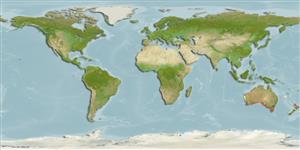Environment: milieu / climate zone / profondeur / distribution range
Écologie
marin; saumâtre récifal. Subtropical
Indo-Pacific: From south-western Australia to New South Wales and Tasmania.
Taille / Poids / Âge
Maturité: Lm ? range ? - ? cm
Max length : 34.0 cm TL mâle / non sexé; (Ref. 9002)
Inhabits shallow rocky reefs, sandy and weedy flats; also in estuaries. Feeds on algae.
Life cycle and mating behavior
Maturité | Reproduction | Frai | Œufs | Fécondité | Larves
Scott, T.D., C.J.M. Glover and R.V. Southcott, 1974. The marine and freshwater fishes of South Australia. A.B. James, Government Printer, South Australia. 2nd ed. 392 p. (Ref. 2156)
Statut dans la liste rouge de l'IUCN (Ref. 130435: Version 2025-1)
Menace pour l'homme
Harmless
Utilisations par l'homme
Pêcheries: commercial
Outils
Articles particuliers
Télécharger en XML
Sources Internet
Estimates based on models
Preferred temperature (Réf.
123201): 14.9 - 20.8, mean 17.5 °C (based on 298 cells).
Phylogenetic diversity index (Réf.
82804): PD
50 = 0.5000 [Uniqueness, from 0.5 = low to 2.0 = high].
Bayesian length-weight: a=0.01479 (0.00674 - 0.03244), b=3.08 (2.89 - 3.27), in cm total length, based on LWR estimates for this (Sub)family-body shape (Ref.
93245).
Niveau trophique (Réf.
69278): 2.0 ±0.00 se; based on food items.
Résilience (Réf.
120179): Milieu, temps minimum de doublement de population : 1,4 à 4,4 années (Assuming tm=2-4.).
Fishing Vulnerability (Ref.
59153): Low vulnerability (24 of 100).
🛈
Nutrients (Ref.
124155): Calcium = 39.8 [16.3, 67.4] mg/100g; Iron = 0.601 [0.337, 1.139] mg/100g; Protein = 19.1 [17.8, 20.4] %; Omega3 = 0.139 [0.073, 0.257] g/100g; Selenium = 13 [6, 30] μg/100g; VitaminA = 25.9 [5.7, 119.0] μg/100g; Zinc = 1.15 [0.73, 1.97] mg/100g (wet weight);
